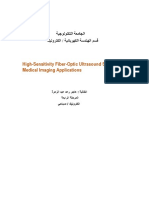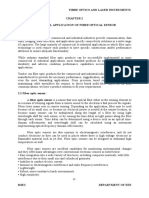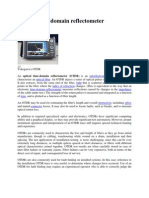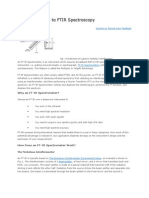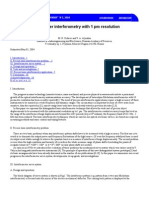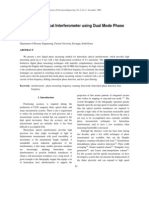2.1 Theory of Interferometric Length Measurement
2.1 Theory of Interferometric Length Measurement
Uploaded by
Yuli JimenezCopyright:
Available Formats
2.1 Theory of Interferometric Length Measurement
2.1 Theory of Interferometric Length Measurement
Uploaded by
Yuli JimenezOriginal Description:
Original Title
Copyright
Available Formats
Share this document
Did you find this document useful?
Is this content inappropriate?
Copyright:
Available Formats
2.1 Theory of Interferometric Length Measurement
2.1 Theory of Interferometric Length Measurement
Uploaded by
Yuli JimenezCopyright:
Available Formats
Review of length measuring interferometers
41
CHAPTER 2
REVIEW OF LENGTH MEASURING
INTERFEROMETERS
Lux, etsi per immunda transeat, non inquinatur.
(Light, even though it passes through pollution, is not polluted.)
St. Augustine
2.1 THEORY OF INTERFEROMETRIC LENGTH MEASUREMENT
The basic principles of length measurement using interferometry were demonstrated in
the reverse sense by Michelson in 1892 when he measured the wavelength of the red
light from cadmium in terms of the International Prototype Metre.
The principle of length measurement by interferometry is straightforward - it is the
comparison of a mechanical length (or a distance in space) against a known wavelength
of light. This may be expressed in a simple equation
L = (N + f )
(2.1)
where L is the length being measured, is the wavelength, N is an integer and f is a
fraction (0 < f < 1). Commonly the optics are arranged such that the light beam
measures exactly double the required length (i.e. it is a double-pass system), in which
case the measurement units, fringes, are half-wavelengths.
L = (N + f )
(2.2)
i.e. one interference fringe corresponds to a distance or length equal to / 2 . By using
a light source for which is known (e.g. laser, gas discharge lamp), measurement of N
and f leads directly to a value for L.
When using sources of visible light the wavelength of the light is small, typically 400 700 nm and hence the basic unit of measurement, one fringe, is 200 - 350 nm in size.
Hence knowledge of N alone provides a measurement resolution of 200 - 350 nm. For
42
Chapter 2
comparison, a typical atomic spacing is of the order of 0.5 nm, so the tick marks on an
interferometric ruler are spaced 400 - 700 atoms apart.
By careful analysis of these interference fringes, it is possible to sub-divide them (and
hence measure f) to a resolution of 1/100 to 1/1000 of a fringe - the minor tick marks on
the ruler are represented by single atoms.
By using sources with much smaller wavelengths (e.g. x-rays), the size of each fringe
can be reduced to 0.2 nm, and fringe sub-division yields a measurement resolution in
the picometre range [1]. Alternatively, the complications of x-ray optics and fringe
detection may be avoided by using a many-pass arrangement of optics in which the
measurement beam traverses the object length many times, by multiple reflection from
slightly tilted mirrors. (This should not be confused with multiple-beam interferometers
such as the Fabry-Perot design. In the former, each point in the interference pattern is
the summation of two beams, which have travelled in many passes, whereas in the latter
(Fabry-Perot), each point is the summation of many beams, which have travelled
different path lengths - see 2.4.2).
2.2 BASIC INTERFEROMETER TYPES
There are many types of interferometer using a variety of techniques, mostly using
lasers as their light source. Each design of interferometer is suited to a particular
situation and has certain advantages and disadvantages for interferometry of length
bars. These will now be examined.
The first distinction that can be made between interferometer types is whether they are
dynamic or static. Dynamic interferometers are usually fringe counting interferometers,
often with a small beam diameter. Static interferometer designs, on the other hand, are
often large field, and are typically used for optical testing.
2.3 REVIEW OF SMALL FIELD, DYNAMIC INTERFEROMETERS
2.3.1 Fringe counting interferometry
In the simplest type of fringe counting interferometer, one of the mirrors is moved
whilst the other remains stationary. As the interference fringes cross a detector,
typically a photodiode, the number of maxima or minima in the signal are counted by a
simple circuit. No attempt is made to sub-divide the fringe count. The resolution of this
Review of length measuring interferometers
43
type of interferometer is thus limited to the size of one interference fringe, typically 300
nm.
In fringe counting interferometers with interpolation, the output beam of a laser is split
into two. After travelling along the reference and measurement paths the beams
interfere with each other and are split again. One beam is given an extra phase
difference of /4 to produce two orthogonal outputs for example by using a quarterwave plate, as in figure 2.1, or by using a specially coated beamsplitter [2]. Two
detectors view these two outputs which are in phase quadrature and the signals from
these two detectors, after suitable processing, are used to drive a bi-directional counter.
By using a fringe interpolator using look-up tables or computer processing, each fringe
can be sub-divided to the 1/1000 fringe level to provide the potential for more accurate
measurement.
FIXED
CORNER-CUBE
BEAM
SPLITTER
FROM
LASER
MOVEABLE
CORNER-CUBE
DETECTOR
/4
DETECTOR
Figure 2.1 - Schematic diagram of a fringe counting interferometer
The main disadvantage of using a fringe counting system is that it provides only
relative measurements of distance and requires accurate setting at two defined points to
define a length. In the measurement of absolute lengths, the optical path difference of
the fringe counting interferometer must be increased by a distance equal to the length of
the object to be measured. This can be done by traversing a mirror on a linear stage
between two points coincident with the two ends of the object to be measured, see
figure 2.2, or by using the interferometer to monitor the position of the probe of a coordinate measuring machine.
44
Chapter 2
DETECTORS
OBJECT
LASER
MOVEABLE
MIRROR
FIXED MIRROR
Figure 2.2 - Use of fringe counting to measure the length of an object
This system is then prone to alignment errors. There are three axes which must be
coincident: the central axis of the object, the axis of the linear stage and the axis of the
interferometer beam. Any mis-alignment of one of these will lead to a length dependent
error.
The fringe interpolation is also prone to errors. If the amplitudes of the two orthogonal
signals are not equal or their phase difference is not exactly /2, then the interpolation
will be incorrect. Table 2.1 gives typical values for fringe interpolations errors for a
commercial fringe counter with 1/1000 fringe interpolation. Use of a computer curve
fitting algorithm to fit an ellipse to the intensity data can sometimes be used to increase
the accuracy [3].
Parameter
Gain mis-match
DC offset
Phase difference
Error in parameter
Error in fringe fraction
5%
0.004
10 mV
0.001
0.010
Table 2.1 - Typical fringe interpolation errors (FT Technologies FT612AS)
The speed of measurement is also important to the overall accuracy. Any fringe
counting system which relies on the translation of a moveable mirror or mechanical
probe will require a finite amount of time for the probe to move between the two ends
of the object. The speed of movement is not usually limited by the ability of the fringe
counter to track the fringes as the probe is moved since fringe counting rates up to 20
MHz may be easily achieved, corresponding to a velocity of 6 m s-1. However it takes a
few seconds to accelerate and decelerate the probe and mount. With a settling time of a
few seconds before the fringe interpolation can be made accurately this requires a total
Review of length measuring interferometers
45
of approximately 10 seconds during which any movement in the bar or optical
components, any drift in refractive index or thermal expansion of the bar will cause an
error in the measurement.
2.3.2 Heterodyne fringe counting interferometry
The field of heterodyne interferometry has been made accessible due to the very narrow
linewidths of lasers which allows the observation of beats between two laser
frequencies. The technique has resulted in a commercial design of interferometer
(Hewlett-Packard 5528A) which can be used for distance measurement of path lengths
up to 60 metres [4]. The instrument contains a He-Ne laser in which a longitudinal
magnetic field splits the output beam into two components (Zeeman splitting) which are
separated in frequency by 2 MHz. These two components have opposite circular
polarisations which are converted into orthogonal linear polarisations after passage
through a quarter wave plate. A polarising beamsplitter directs one polarisation to a
fixed corner-cube which acts as a reference whilst the other beam is directed to the
moveable corner-cube, see figure 2.3. The beat frequency between the two beams is
detected and combined with a reference frequency in a differential counter. When the
mirrors are stationary these two frequencies are equal, however if one of the cornercubes is moved there is a frequency difference signal which can be used to monitor the
change in path length between the two arms.
FIXED
CORNER
CUBE
/4
POLARISERS
LASER
MOVING
CORNER
CUBE
POLARISERS
DETECTORS
DIFFERENTIAL
COUNTER
Figure 2.3 - Schematic diagram of a heterodyne fringe counter
The conventional arrangement of the Hewlett-Packard system offers a resolution of
10 nm, though this can be improved by using multiple-pass interferometry where the
beam traverses the measurement path many times.
46
Chapter 2
The drawbacks with this system are similar to those of the simple fringe counting
system above. This type of interferometer is used in many industrial calibration
laboratories where the wavelength of the laser is calibrated to provide traceability.
2.3.3 Two-wavelength fringe counting interferometry
By illuminating an interferometer sequentially with two wavelengths 1 and 2, the
effective range is that which would be obtained with an effective wavelength e
e =
12
1 2
(2.3)
Measurements have been made with carbon dioxide lasers [5] where the laser output
wavelength is switched rapidly between two wavelengths as one of the mirrors of the
interferometer is moved. Matsumoto [6] has investigated measurement of distances up
to 100 m to an accuracy of 1 part in 107. Error sources for this technique include the
alignment of the paths, the accuracy of the laser wavelengths (including refractive
index effects) and the accuracy of the fringe interpolation performed in the computer.
2.3.4 Other fringe counting systems
Kubota [7] employed a frequency modulating interferometer using semiconductor
lasers where polarised beams were combined to produce fringe patterns with intensities
in phase quadrature. The absolute measurement of distance was performed by sweeping
the frequency of the laser by ramping the supply current. Detection of the beat
frequency provided information about the path difference between the two arms of the
interferometer. The accuracy of the system is limited by the accuracy of the wavelength
measurement whilst sweeping.
Other authors have used direct modulation of the laser output intensity using feedback.
In this scheme the moveable mirror reflects the beam back into the laser cavity and thus
acts as an extended external cavity [8,9,10]. The drawback with this scheme is that the
feedback affects the ability of the laser to stabilise at a single mode and hence the
absolute value of the laser wavelength cannot be maintained.
In order to overcome the limitations described above, a system for the measurement of
length bars must be static, i.e. the measurements must be performed with little or no
Review of length measuring interferometers
47
movement of the optical components or mechanical parts of the system including the
object or length bar to be measured. A drawback of using a dynamic fringe counting
interferometer is that it does not directly measure the positions of the end faces of the
bar, rather it measures the positions of the interferometer mirrors, which require
accurate setting at the opposite ends of the bar. Better accuracy can be achieved by
measuring the bar directly and using its flat polished end faces as the optical mirrors in
the interferometer.
The system must therefore be able to detect, image or otherwise measure the positions
of the two ends of the bar simultaneously. The laser source must operate at an
accurately known wavelength such that the distance between the ends of the bar can be
measured in terms of interference fringes of a known, fixed size. The interference
pattern generated by the interferometer must be amenable to analysis to allow fringe
sub-division to the nanometre level. These conditions are satisfied by using a large
aperture interferometer. The effect of laser beam diffraction is also minimised by
increasing the aperture of the interferometer.
2.3.5 The effect of laser beam diffraction on measured length
Due to the spread of wavevectors in a gaussian laser beam, there is a slight alteration to
the longitudinal propagation speed of parts of the wavefront. This can be estimated as
follows.
|k| =/c
w0
beam waist
Figure 2.4 - Laser beam waist - alteration of effective propagation speed
The effective propagation speed is reduced by
k (1 cos )
with
w0
(2.4)
(2.5)
Chapter 2
48
where is the wavelength and w0 is the minimum beam diameter (waist). Therefore the
correction to the measured distance is approximately
or
2
2w0 2
For an expanded laser beam used in an interferometer with aperture 80 mm, this
evaluates to ~3 x10-11, and is thus negligible. A more detailed derivation is given by
Rowley [11] and is reproduced here, to confirm the approximate estimate. The
combined effect of the wavefront curvature and the propagation phase shift on D, the
distance measured by the interferometer, is given by
D = D
arctan
2 w0 2
2
2
D D 1
4 2 w0 2
(2.6)
(2.7)
Substituting = 633 nm, w0 = 80 mm (beam diameter), the result is
D = D(1 - 1.6 x10-12)
i.e. negligible. This is the same result as that of Dorenwendt and Bnsch [12]. Mana
[13] obtained the result
2 2
2 w2
(2.8)
which is approximately 10-10. Thus by using an expanded beam in the interferometer,
rather than the conventional unexpanded laser beam size of 1 - 2 mm diameter,
diffraction effects due to the beam waist can be made negligible.
2.4 REVIEW OF LARGE-FIELD INTERFEROMETER DESIGNS
2.4.1 The Fizeau interferometer
The most common large field interferometer is the Fizeau interferometer. This requires
the minimum of optical components: a light source, collimating lens, reference flat and
test surface, see figure 2.5. The source and return beams are coincident unless the
Review of length measuring interferometers
49
source is positioned slightly off-axis which then leads to an obliquity effect (see
4.1.3). The profile of the fringes in a Fizeau interferometer with tilt is determined by
the reflection and transmission coefficients of the optical surfaces used.
Figure 2.5 - Standard Fizeau interferometer
To overcome the problem of separating the source and return beams it is common to
use an extra beamsplitter in the collimator path to re-direct the output beam, figure 2.6.
Figure 2.6 - Modification to Fizeau interferometer
Care has to be taken to minimise extra reflections from the beamsplitter secondary
surface, e.g. by using an anti-reflection coating. Typical fringe intensity profiles can be
seen in figure 2.7. These were calculated from equation 2.9, for values of R from 0.1 to
0.9, where R = R1R2 , and R1 = R2.
(1 R ) (1 R )
I =1
1+ (R R ) 2R R cos(2m )
2
(2.9)
R1 and R2 are the reflectivities of the two surfaces and m is the order of interference.
50
Chapter 2
Figure 2.7 - Normalised intensity profiles of fringes in a Fizeau interferometer for values of the
reflectivity (R) ranging from 0.1 (lowest curve) to 0.9 (uppermost curve), according to equation 2.9
2.4.2 The Fabry-Perot interferometer
In fact the Fizeau interferometer may be regarded as a version of the Fabry-Perot
interferometer which uses multiple reflection to achieve narrow profile fringes
especially suited to spectroscopic work.
Figure 2.8 - Fabry-Perot interferometer
2.4.3 The Michelson interferometer
By introducing the extra beamsplitter to the Fizeau interferometer, the number of
optical components has equalled that found in another common interferometer, the
Michelson interferometer. Here a beamsplitter at 45 is used to split the incoming beam
into two (amplitude division) which are directed to two mirrors: the reference mirror
and the test mirror, and then recombined.
Review of length measuring interferometers
51
Figure 2.9 - Michelson interferometer
The Michelson interferometer produces different types of fringes according to the path
difference between the two arms and whether or not any tilt has been introduced. It is
common to use a compensating plate in the Michelson interferometer to account for the
path difference between the two beams since one of them passes through the glass of
the beamsplitter 3 times whereas the other passes through only once.
2.4.4 The Twyman-Green interferometer
When the Michelson interferometer is used with a collimated beam of light the
arrangement is called the Twyman-Green interferometer [14].
Figure 2.10 - Twyman-Green interferometer
The Twyman-Green interferometer is ideal for measurements of surface shape and
surface texture as it offers a large field with sinusoidal fringes of good contrast and has
the added advantage that by careful positioning of the reference mirror, twice the
coherence range of the Fizeau interferometer can be obtained when imaging extended
52
Chapter 2
objects, i.e. by positioning the reference mirror at an optical path equal to half the
length of the extended object to be imaged, the useable coherence is doubled, see figure
2.11.
Figure 2.11 - Coherence depth doubling by positioning of reference mirror
Thus for a source of coherence length 50 mm, by using a Twyman-Green arrangement
as opposed to a Fizeau system, objects up to 100 mm can be measured.
Whilst the narrow fringes of the Fizeau/Fabry-Perot interferometer are ideal for fringe
locating and tracking algorithms, the sinusoidal nature of the fringes in a TwymanGreen interferometer are ideal for analysis by phase-stepping techniques which offer
potentially greater accuracy of fringe interpolation approaching 1/100 to 1/1000 fringe
(see chapter 5). Although it is possible to use phase-stepping with a Fizeau
interferometer (see 5.3.7.3), the analysis is more complex and requires symmetrical
fringe profiles.
2.4.5 Other designs of length measuring interferometer
Previous interferometers for the measurement of end standards of length have included
the NPL Automatic Gauge Block Interferometer (Twyman-Green), NPL-Hilger
interferometer (Fizeau) and the Ksters-Zeiss interference comparator which used a
precision Ksters prism as the beamsplitter/combiner, shown in figure 2.12.
Review of length measuring interferometers
53
Figure 2.12 - Ksters-Zeiss interference comparator
2.5 PRIMARY LENGTH BAR INTERFEROMETER - BASIC
INTERFEROMETER TYPE
Of the designs investigated, the Twyman-Green design was chosen as the basis for the
Primary Length Bar Interferometer. The large field makes it possible to view
interference fringes over the whole of the surface of the bar and hence measure surface
form. The sinusoidal fringe intensity is ideal for analysis by phase-stepping
interferometry (see chapter 5), the alignment is straightforward and the coherence-depth
sufficient (given a relatively small source).
To measure the length of the bar, it is attached to a reference flat or platen, as shown in
figure 2.13.
Figure 2.13 - Twyman-Green interferometer for the measurement of length bars
54
Chapter 2
2.5.1 The technique of wringing
The platen is attached to the bar by the process of wringing. In this process the
surfaces of the bar and platen are thoroughly cleaned using acetone to remove all
presence of oils, dirt and dust. A small drop of a solution of wringing fluid (liquid
paraffin diluted 1:50 in Arklone (1,1,2 Trichloro-1,2,2 Trifluoro-Ethane)), is smeared
over the surface of the platen and polished off with a tissue until none can be seen by
the naked eye. The platen is then slid onto the end of the bar whilst the two are in plane
contact. During this process, the bar rests on temporary supports to allow access to the
end of the bar.
P
L
A
T
E
N
LENGTH BAR
TEMPORARY
SUPPORTS
Figure 2.14 - Wringing a platen onto the end of a length bar
If the surfaces of the bar and platen are sufficiently flat and polished/lapped, molecular
attraction takes place between the two surfaces and the molecular layer of paraffin
between them. This attraction is strong enough to support the weight of the platen.
Previous work [15] has shown that the wringing thickness - the apparent separation
between the two surfaces, is typically 7 nm ( 5 nm), and is not dependent on the
amount of wringing fluid or its composition. The wringing was also proved to be a
definite attraction rather than the effects of air pressure holding the two surfaces
together (wringing can take place in a vacuum). The effects of surface tension have also
been shown to be minimal in this situation. The wringing is much stronger when a
wringing fluid is used on slightly rough surfaces, i.e. surfaces which are
macroscopically flat, but not highly polished. It is thought that this is due to penetration
of the wringing fluid into the sub-microscopic interstices of the platen leading to a
larger surface area in good contact with the bar.
The size of the wringing film layer is taken into account when defining the length
represented by a length bar. BS 5317 states:
Review of length measuring interferometers
55
Length ... is defined, with the bar mounted horizontally and referred to the standard
reference temperature of 20 C ... as the distance from the centre of one of its faces to a
flat surface in wringing contact with the opposite face, measured normal to the surface.
There is an advantage in using a wrung length standard in that the length can be
represented by a step height which allows measurement by probing in one direction; the
probes can be optical, capacitive, linear variable differential transformers (LVDTs) or
touch-trigger probes of CMMs. The penetration of the probe into the surface of the bar
and platen due to phase effects (optical probes) or material compression (mechanical
probes) is then accounted for, if the platen and bar are of the same material. This is not
true if the object is probed from different directions.
Chapter 2
56
REFERENCES FOR CHAPTER 2
[1]
Franks A Nanometric surface metrology at the National Physical Laboratory
Metrologia 28 (1992) 471-482
[2]
Raine K W & Downs M J Beam-splitter coatings for producing phase
quadrature interferometer outputs Opt. Acta 25 (1978) 549-558
[3]
Birch K P Optical fringe subdivision with nanometric accuracy Precis. Eng.
12 (1990) 195-199
[4]
Dukes J N & Gordon G B A two-hundred-foot yardstick with graduations every
microinch Hewlett-Packard J. 21 (1970) 2-8
[5]
Gillard C W & Buholz N E Progress in absolute distance interferometry Opt.
Eng. 22 (1983) 348-353
[6]
Matsumoto H Synthetic interferometric distance measuring system using a
CO2 laser Appl.Opt. 25 (1986) 493-498
[7]
Kubota T, Nara M & Yoshimo T Interferometer for measuring displacement
and distance Opt. Lett. 12 (1987) 310-312
[8]
Ashby D E T F & Jephcot D F Measurement of plasma density using a gas laser
as an infrared interferometer Appl. Phys. Lett. 3 (1963) 13-16
[9]
Dandridge A, Miles R O & Giallorenzi T G Diode laser sensor Electron. Lett.
16 (1980) 948-949
[10]
Yoshino T, Nara M, Mnatzakanian S, Lee B S & Strand T C Laser diode
feedback interferometer for stabilization and displacement measurements Appl.
Opt. 26 (1987) 892-897
[11]
Rowley W R C Laser wavelength measurements and standards for the
determination of length Precis. Meas. & Fund. Constants, NBS Spec. Publ. 617
(1984) 57-64
[12]
Dorenwendt K & Bnsch G ber den Einflu auf die interferentielle
Lngenmessung Metrologia 12 (1976) 57-60
[13]
Mana G Diffraction effects in optical interferometers illuminated by laser
sources Metrologia 26 (1989) 87-93
[14]
Twyman F & Green A (1916) British Patent 103832
[15]
Rolt F H Gauges and Fine Measurement (MacMillan & Co.: London) (1929)
You might also like
- Michelson InterferometerDocument5 pagesMichelson InterferometerJiya Khan100% (1)
- Mach-Zehnder Interferometer - WikipediaDocument7 pagesMach-Zehnder Interferometer - WikipediaAndreiCabaNo ratings yet
- Unit Iii Advances in Metrology 12Document8 pagesUnit Iii Advances in Metrology 12rajamanickam sNo ratings yet
- 2000 - Calibration of Displacement Sensors Up To 300um With Nanometre Accuracy and Direct Traceability To A Primary Standard of LengthDocument9 pages2000 - Calibration of Displacement Sensors Up To 300um With Nanometre Accuracy and Direct Traceability To A Primary Standard of Lengthamin342No ratings yet
- هاجر رعد PDFDocument7 pagesهاجر رعد PDFHajar RaadNo ratings yet
- Displacement Measuring Interferometry Measurement UncertaintyDocument6 pagesDisplacement Measuring Interferometry Measurement UncertaintyJDNo ratings yet
- A Scintillator Based Halo-Detector For Beam Position MonitoringDocument3 pagesA Scintillator Based Halo-Detector For Beam Position MonitoringSean Captain HonestlagoNo ratings yet
- Optical Spectrum AnalysisDocument21 pagesOptical Spectrum AnalysisAkshatNo ratings yet
- Ir SpectrometersDocument10 pagesIr SpectrometersVinícius FavrettoNo ratings yet
- Unit 4Document27 pagesUnit 4S. SARGUNA THAMIZHAN MECHNo ratings yet
- Fiber OpticsDocument18 pagesFiber OpticsChris JoshNo ratings yet
- Unit-Iv Laser MetrologyDocument48 pagesUnit-Iv Laser MetrologySaravanan ShriNo ratings yet
- Technical Terms: Unit V Laser and Advances in Metrology 10 HrsDocument27 pagesTechnical Terms: Unit V Laser and Advances in Metrology 10 HrsBHOOMINo ratings yet
- Unit IvDocument36 pagesUnit Ivsreejith2786No ratings yet
- New Microsoft Office Word DocumentDocument7 pagesNew Microsoft Office Word Documentanon_514299896No ratings yet
- Laser MetrologyDocument41 pagesLaser MetrologyjennybunnyomgNo ratings yet
- Pro CH-1Document7 pagesPro CH-1Barkhad MohamedNo ratings yet
- First Assignment of Experimental Physics Lab ": The Use of Spectromter"Document34 pagesFirst Assignment of Experimental Physics Lab ": The Use of Spectromter"Md Rubel hosainNo ratings yet
- Laser Interferometers (Metrology) : Fig. 6.31. AC InterferometerDocument7 pagesLaser Interferometers (Metrology) : Fig. 6.31. AC InterferometerVinoth KumarNo ratings yet
- A Fiber Optical Sensor For Non-Contact Vibration MeasurementsDocument2 pagesA Fiber Optical Sensor For Non-Contact Vibration MeasurementsEd TrawtmamNo ratings yet
- Laser Telemetric SystemDocument5 pagesLaser Telemetric SystemDurai Raj100% (1)
- Unit Iii Advances in Metrology 12Document15 pagesUnit Iii Advances in Metrology 12rajamanickam sNo ratings yet
- FOL Unit 4Document7 pagesFOL Unit 4Sudhar SanNo ratings yet
- Crystals 11 00801Document8 pagesCrystals 11 00801Kumar VelNo ratings yet
- Distance-Dependent Dual-Cavity Fibre Interferometer For Vibration AnalysisDocument6 pagesDistance-Dependent Dual-Cavity Fibre Interferometer For Vibration AnalysisShina MaliakkalNo ratings yet
- IR InstrumentationDocument8 pagesIR InstrumentationVedika SeepersadNo ratings yet
- Chromatic Dispersion Measurement: The EXFO Phase Shift MethodDocument3 pagesChromatic Dispersion Measurement: The EXFO Phase Shift MethodahmedNo ratings yet
- Optical Fiber Practical 3 - OTDRDocument12 pagesOptical Fiber Practical 3 - OTDRNadun2020No ratings yet
- A Novel Technique For Measuring The Pulsewidth of Nanosecond Laser PulsesDocument4 pagesA Novel Technique For Measuring The Pulsewidth of Nanosecond Laser PulsesGindra WinaldiNo ratings yet
- Wideband Multiprobe Microwave Multimeter: Vladimir M. Volkov, B. ZaichenkoDocument3 pagesWideband Multiprobe Microwave Multimeter: Vladimir M. Volkov, B. ZaichenkoArif HurairahNo ratings yet
- Straightness Measurements For Accelerator StructuresDocument14 pagesStraightness Measurements For Accelerator Structureselson_paulNo ratings yet
- A Multichannel Dosimeter Based On Scintillating Fibers For Medical ApplicationsDocument5 pagesA Multichannel Dosimeter Based On Scintillating Fibers For Medical ApplicationsMahdi Norooz OliaeiNo ratings yet
- 1 s2.0 S0924424724000931 MainDocument11 pages1 s2.0 S0924424724000931 Mainopenjavier5208No ratings yet
- Unit 4Document28 pagesUnit 4scorpionarnoldNo ratings yet
- Unit 4 MetrologyDocument12 pagesUnit 4 MetrologyMuthuvel M89% (9)
- Physics 262 Lab #4: Interferometer John YamrickDocument8 pagesPhysics 262 Lab #4: Interferometer John YamrickAndrea BonfissutoNo ratings yet
- EI 8075 Fibre Optics and Laser Instruments Industrial Application of Fiber Optical SensorDocument21 pagesEI 8075 Fibre Optics and Laser Instruments Industrial Application of Fiber Optical Sensorsyed1188100% (1)
- EI 8075 Fibre Optics and Laser Instruments Industrial Application of Fiber Optical SensorDocument21 pagesEI 8075 Fibre Optics and Laser Instruments Industrial Application of Fiber Optical Sensorsyed1188No ratings yet
- EI 8075 Fibre Optics and Laser Instruments Industrial Application of Fiber Optical SensorDocument21 pagesEI 8075 Fibre Optics and Laser Instruments Industrial Application of Fiber Optical Sensorsyed1188No ratings yet
- Fiber MeasurementsDocument60 pagesFiber MeasurementsAnkita Dashora91% (11)
- Optical Time-Domain ReflectometerDocument3 pagesOptical Time-Domain ReflectometerBiju KmNo ratings yet
- Introduction To FTIR SpectrosDocument12 pagesIntroduction To FTIR SpectrosĐào Văn Hoạt100% (1)
- Sakai Chapter 3Document20 pagesSakai Chapter 3Ronnel Mendoza VasquezNo ratings yet
- SpectrophotometerDocument4 pagesSpectrophotometerkhushbakhat085No ratings yet
- Q.4:-Elaborate With Diagram Working Principle, Salient Features, Solution:-Optical Coherence Tomography (OCT) Is A Non-ContactDocument4 pagesQ.4:-Elaborate With Diagram Working Principle, Salient Features, Solution:-Optical Coherence Tomography (OCT) Is A Non-ContactJay The PerfectNo ratings yet
- Interferometric SeismometerDocument6 pagesInterferometric SeismometerVistaNo ratings yet
- Michelson InterferometerDocument5 pagesMichelson InterferometerSajadSidiqNo ratings yet
- Scanning Laser Doppler Anemometer and Its Application in Turbulent Separated OwDocument7 pagesScanning Laser Doppler Anemometer and Its Application in Turbulent Separated OwSulaiman NurhidayatNo ratings yet
- Laser InterferometerDocument33 pagesLaser InterferometerShree Ram PandeyNo ratings yet
- Optical Measurement: Interference of Light. Instruments Designed To Measure Interference Are Known As InterferometersDocument5 pagesOptical Measurement: Interference of Light. Instruments Designed To Measure Interference Are Known As InterferometersDeepak KumarNo ratings yet
- Heterodyne Interferometer Using Dual Mode PhaseDocument8 pagesHeterodyne Interferometer Using Dual Mode PhaseVistaNo ratings yet
- Sensors 19 03989Document13 pagesSensors 19 03989Ahlam BOUANINo ratings yet
- A_Polarization-Space_Michelson_Interferometric_Fiber-Optic_Vibration_SensorDocument9 pagesA_Polarization-Space_Michelson_Interferometric_Fiber-Optic_Vibration_SensortshangNo ratings yet
- FOL Unit 4 PDFDocument7 pagesFOL Unit 4 PDFShaik RoshanNo ratings yet
- J. Filevich Et Al - Dense Plasma Diagnostics With An Amplitude-Division Soft-X-Ray Laser Interferometer Based On Diffraction GratingsDocument3 pagesJ. Filevich Et Al - Dense Plasma Diagnostics With An Amplitude-Division Soft-X-Ray Laser Interferometer Based On Diffraction GratingsMutrexczNo ratings yet
- Nano-Metrology Based On The Laser Interferometers: Saeed Olyaee and Samaneh HamediDocument28 pagesNano-Metrology Based On The Laser Interferometers: Saeed Olyaee and Samaneh HamediIsmoy JatiNo ratings yet
- OSApapierDocument11 pagesOSApapierLuc FroehlyNo ratings yet
- Handbook of Ultra-Wideband Short-Range Sensing: Theory, Sensors, ApplicationsFrom EverandHandbook of Ultra-Wideband Short-Range Sensing: Theory, Sensors, ApplicationsNo ratings yet
- Signal Integrity: From High-Speed to Radiofrequency ApplicationsFrom EverandSignal Integrity: From High-Speed to Radiofrequency ApplicationsNo ratings yet




